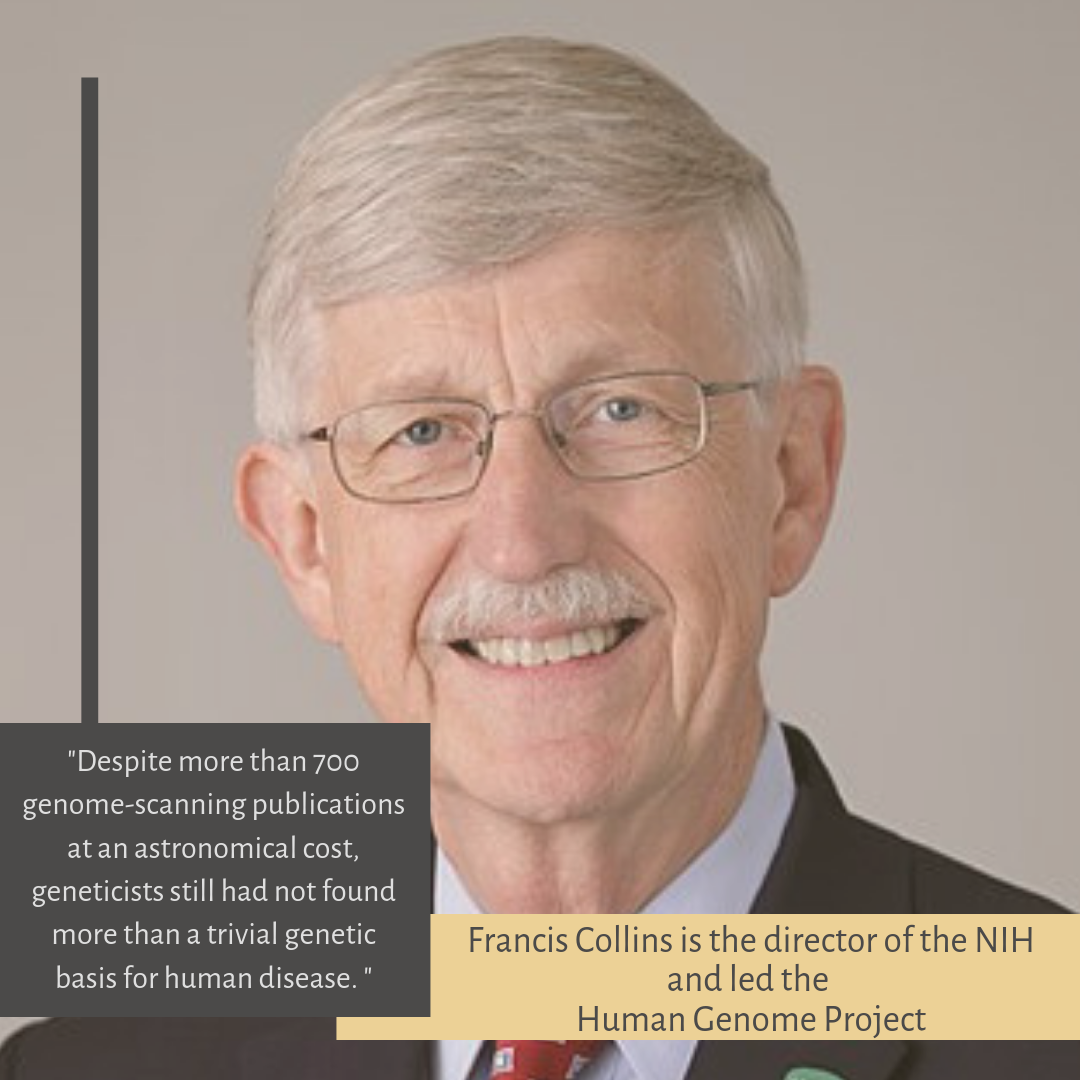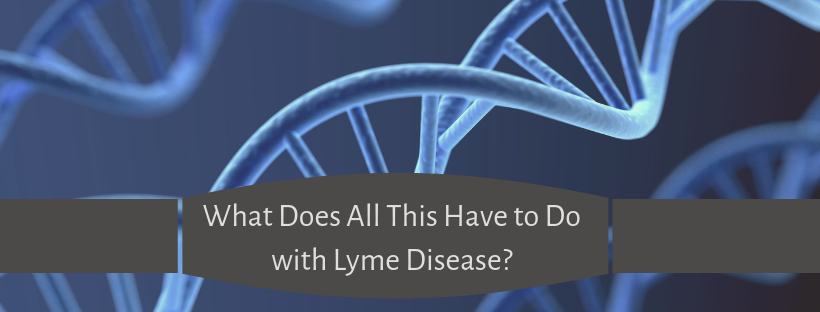Ayurvedic Medicine and the Epigenetics of Lyme Disease by Dr. Scott Gerson (Part One)
Background
There are several relatively rare human diseases that have been linked to genetic mutation which, with the earliest development of gene sequencing technology in the 1970’s, triggered the effort to sequence the entire human genome and search for the genetic basis of disease. That effort began in earnest with the approval of congressional funding in 1988 and the appointment of James Watson (of Crick and Watson) as the director. Fifteen years later, the goal of sequencing the human genome had been accomplished.
Then in the decade following the 2003 completion of the sequencing of the human genome, hardly a week went by without some new genetic “breakthrough” being reported. The discovery of genes for a specific disease always gets great media coverage, usually based on publication in a respected scientific journal such as Science or Nature. There have been many examples of this over the past few years: the reported discovery of five genes associated with Alzheimer’s disease, the gene regulating production of serotonin (mutation predisposes to depression), and many others. But take a closer look and the reality of these gene-disease associations fall apart.
Among all the genetic findings for common diseases such as heart disease, cancer, and mental illnesses, only a handful are of genuine significance for human health. The same is certainly true for Lyme disease as we shall see. Defective genes rarely cause, or even mildly predispose us, to disease, and as a consequence the science of human genetics is in deep crisis.
The $100 billion human genome sequencing project was based on a huge, but calculated, gamble. The leading scientists of the project believed that defective genes inherited from our parents or caused by a spontaneous mutation were probably the cause of most disease. To support their hypothesis they pointed to the fact that many rarer diseases were already known to be genetic (sickle-cell anemia, cystic fibrosis, Tay-Sachs disease, Huntington’s disease). So it seemed a small leap to expect that inherited or acquired flaws would underlie common diseases too.
There was, however, a problem with the basis for their confidence. The best scientific evidence in humans for genes as causes of common disease was based on comparing disease rates in genetically identical (monozygotic) twins against rates in non-identical (fraternal) twins, who share only 50% of their DNA. These comparisons, called heritability studies, aimed to measure the relative contributions of genetic variation (“nature”) versus environmental variation (“nurture”).
Although extremely widely used and cited, these studies were considered meaningless by many geneticists. These critics pointed out that these studies rest on two fundamentally flawed assumptions:
Monozygotic (identical) twins are genetically identical
Parents and society treat monozygotic and dizygotic twins exactly the same (the so-called “equal environments assumption”)
Both of these assumptions are unambiguously and absolutely untrue.
However, although these objections constituted a scientifically valid threat to the genome project, they were ultimately swept aside and all but forgotten for political and financial reasons.
In 2009, one of the few remaining scientists of the original genome project, Francis Collins, published a review paper in the scientific journal Nature, along with 26 other prominent geneticists. It was entitled Finding the Missing Heritability of Complex Diseases. In it, the authors acknowledged that, despite more than 700 genome-scanning publications at an astronomical cost, geneticists still had not found more than a trivial genetic basis for human disease.
Since the Collins paper was published nearly ten years ago that conclusion remains unchanged. It is now clear that the original identical twin-study critics were absolutely correct. The reason why genes for common diseases, including Lyme disease, have not been found is that, with rare exceptions, they do not exist. Disturbingly, as more and more failures to find significant gene-disease associations have been reported, geneticists have remained silent.
The failure to find meaningful inherited genetic disease predispositions is likely the most profound and expensive failed experiment that science has ever experienced. What’s worse, it failed to reach a goal it assured the world with much swagger that it would soon achieve.
But here is a silver lining to all this. It has prompted the question: if defective genes are not to blame for human illness, then what is?
The answer to that question is epigenetics.
“Epigenetics” refers to that which is applied “upon the genes.” Use of this term in scientific explanations of developmental biology is usually credited to Conrad H. Waddington in 1942. Today, epigenetics usually refers to changes in the genetic material that affect gene expression without affecting the DNA sequence itself.
Epigenetic explanations are important since they provide a mechanistic account of how environmental and genetic factors interact in biological processes such as development and the onset of disease.
Central to the concepts of epigenetics are mechanistic explanations of how various modifications (not changes in sequence or mutations) made to the genetic material can affect gene expression. Today, the emerging field of epigenetics is introducing a new level of explanation into the explanatory framework used by scientists to explain the development of complex illnesses.
Epigenetics shows—among other things—that a person's experience may directly affect their DNA. Preliminary research shows that people can use yogic breathing techniques and awareness exercises to reduce the impact of physical and mental stress at the level of DNA. The effect involves no change to the person's inherited DNA sequence itself, but its expression significantly changes—influenced by one's emotional state and awareness. These epigenetic effects involve chemical modifications of gene regulator regions and have been shown to be stable and heritable, i.e., they can be passed on to the next generation. This means that new epigenetic marks and expressed traits acquired during adulthood may actually get passed on to one's offspring via epigenetic modifications. The mechanism of how this occurs remains a scientific mystery and is the subject of intensive investigation.
The foregoing has focused on the failure of genetics to reveal the basis for disease. But Lyme disease has not been prominently thought of as a genetically-caused condition but rather as a microbial disease. Our society has completely bought the concept that we get sick because of the presence of microbes. This paradigm goes back to Pasteur and the persisting intellectual persuasive power of the Germ Theory of Disease. But is that the complete story, or even the true story?
We now know that there are more microbes in the human body than our own cells. Yet under normal conditions, those microbes do not cause illness of any kind and in fact, make important contributions to our health.
In the case of Lyme disease, however, the narrative that has developed goes something like this: “I was bitten by a tick which regurgitated its stomach contents into my body which introduced Borrelia burgdorferi bacteria into my body…a bulls-eye rash developed around the bite site…and soon many symptoms started showing up. I then had enzyme immunoassay and Western Blot testing and the diagnosis of Lyme disease was confirmed.”
Given our culturally implicit acceptance of the Germ Theory, it certainly sounds plausible that the bacteria caused the illness. But does it really explain everything? Not even remotely.
Consider that only about 40% of people ever develop a bulls-eye rash. Many who test highly positive for the spirochete never develop any symptoms…ever!
How your particular biology responds, and the physical symptoms you develop, may have more to do with your ancestors and with your lifestyle than with the tick bite.
The principle of epigenetic marks may explain some of what makes you uniquely prone to the types of problems you experience that are collectively called Lyme disease. This is not “new age,” nor are we talking about genetic mutations, but it is rather an epigenetic phenomenon. The prefix “epi” means: on top of, external to, above.
An epigenetic trait, by definition, is a predisposition toward certain psychological and/or physical problems that are set in motion by stably heritable changes in chromosomal folding patterns without any alterations in the DNA sequence itself. This altered nucleosomal packing geometry or higher-order folding pattern of chromatin modifies the expression of various genes. What’s more, these epigenetic marks can be inherited. Illnesses and conditions in your family history going back several generations could very likely determine your tendency to develop certain problems. Also, epigenetic marks can be acquired and accumulate within your own lifetime.
I need to emphasize that epigenetic marks are not to be confused with genetic abnormalities, such as missing or mutated genes. Epigenetic marks are more of an energetic abnormality; they are essentially an energetic imbalance or dissonance.
Intuitive knowledge and astute medical observations dating back over 3000 years documented the reality of these epigenetic effects, though the term epigenetics was only coined recently. When researchers on the Human Genome Project realized that instead of the predicted 200,000+ gene sequences they only found humans have only 25,000 they realized that the cause of disease is not to be found in incorrect sequences of genes for most conditions. What this means is anyone who is expecting genetic engineers to be able to come up with a cure for every illness can stop waiting. Therefore the term "epigenetics" was coined to denote the energetic phenomenon that regulates how our DNA is expressed as opposed to the actual physical DNA sequence. DNA sequence is no longer regarded to be the ultimate cause of most human disease. It has inspired me to formulate a new mantra: “Your genes are not your destiny.”
Epigenetic marks could be initiated if illnesses are improperly or incompletely treated. It is today recognized and undisputed and has been shown in animal experiments, that the pattern of epigenetic change in genes can be induced by the environment and passed on to the offspring from ancestors at least several generations back. In other words, some of the tendencies to problems you have could be the result of illnesses, diet, exposures, medicines, and emotional trauma experienced by your great, great, great…grandparents.
It is indeed fascinating and a little frightening to consider what kinds of problems future generations may experience due to different illnesses which are rare today but prevalent in the past. Cholera, smallpox, typhus, scurvy, gonorrhea, syphilis, tuberculosis, cancer, and many more diseases of the past, are today possibly generating a specific set of epigenetically-determined disease tendencies. This is occurring because rather than addressing the underlying energetic causes of these conditions, only suppressive therapies were, and still are, are used to treat them. Antibiotics are a suppressive therapy and, no one would argue, has had lifesaving effects on many infectious diseases. However, on the other hand, antibiotics are a major culprit in the creation of epigenetic marks. The antibiotics do kill most of the bacteria that cause these different illnesses, but they do nothing to address the damage already done by the bacteria on the abnormal bio-electrical forces, folding patterns, and expressions of the patients DNA.
Epigenetic marks can be compared to a computer whose operating system is infected with a virus being used to make other new computers. If the virus doesn’t immediately shut down the entire computer, but rather at first only makes it run slowly or creates minor problems, the unsuspecting programmer may continue to use it to make new computers. The newly made computers will be carrying that same virus in their operating system and eventually, widespread disaster will strike. Epigenetic marks are very much like that computer virus in your body's genome (i.e. its operating system): the epigenetic mark doesn't immediately kill you. In fact, it might not even manifest itself for several generations. It only corrupts various functions of your body's DNA when activated by certain stressors in your life.
Epigenetic marks can and do predispose certain individuals to react to the tick bite and developing the myriad of symptoms we today call Lyme disease. It is very obvious that the bacteria affect the areas of the body, which were epigenetically weakest first, and then as more body systems become compromised they aggressively affect other systems and cause even more symptoms (e.g. psychological, neurological, immunological).
The point that is clear is that if the underlying epigenetic flaws are addressed in advance or even after the initial bite, and the overall coherence and balance of the body can be restored, and simultaneously the microbial load is reduced, we usually see a gradual disappearance of symptoms.
Germs are not the root cause of illness. Borellia burgdorferi infection is not the root cause of Lyme Disease. These statements undoubtedly sound totally unscientific and contrary to everything you thought you knew about infectious disease and Lyme Disease.
Germs simply initiate the reaction in an epigenetically-predisposed individual. An old analogy compares infectious disease to that of an explosion of dynamite. The spark is not the cause of the explosion, it merely initiates the explosive potential of the dynamite. Applying this analogy to Lyme Disease, the spark is the Borellia burgdorferi bacteria, which initiates the disease potential of the individual. If your body has no “explosive potential” then bacteria cannot “ignite” a disease state.
Ayurveda considers the chronic stages of Lyme disease to be a manifestation of asmirti, meaning “a loss of memory.” The intelligence of the physiology has lost the ability to remember the distinction between self and other. In modern parlance this is related to the phenomenon of molecular mimicry. Molecular mimicry occurs when T-lymphocytes (CD4⁺ T cells) bearing receptors for specific pathogens (i.e. B. burgdorferi) cross-react with and attack normal healthy tissues. Many factors and variables including the overall general health of the individual, the bioenergetic (doshic balance) status, the ancestral epigenome status, and the immune repertoire of the individual at the time of exposure will determine the nature of the resulting condition. Current evidence makes it highly unlikely that any one infectious agent alone will be found to be exclusively associated with any one autoimmune-type disease.
High quality research coming from many different scientific disciplines is now seriously questioning the very validity of the Germ Theory of disease. This research is unwittingly slowly unravelling a new broader theory of disease which is very consistent with Ayurvedic Medicine—the ancient Indian system of medicine.
It all began in the 1980’s when public health officials began to notice that rural children were developing less allergies than urban children. They hypothesized that the country kids who play in the dirt and have more contact with nature have more exposure to viruses and bacteria which in some way helps to balance their immune systems. This theory has now been validated by empirical studies worldwide. In fact, many areas of science have reached the same conclusion: our failure to be exposed to a diversity of species is making us sick. The Germ Theory has led us all into the belief that we must all constantly wash our hands, scrub our bodies, and live antiseptic lives. The Germ Theory has focused civilization for 200 years on killing bad species; the new paradigm, while acknowledging that sometimes germs cause illness, is about finding the good species which are missing in our lives. No one who is not predisposed through imbalance/dysfunction can ever develop an infectious disease. We all have innumerable microbes in the tissues of our bodies…quite an understatement when considering 90% of what you think is you (human being) is actually them (microbes). The integrity of the human organism dictates whether or not that infection proceeds to cause the symptoms of infectious disease. You may have a potentially lethal microbe in the tissues and never manifest any disease because of it. However, once an infectious disease is initiated, it will take a course independent of the type of microbe. Its course is dictated by the host’s ability to adapt instantly and correctly to any changes in its internal and external environment, as well as the epigenetic miasms that are altering the person’s adaptability. This is why 600 thousand people can have the same type of bacterial infection and yet have totally different symptoms.
With the Human Genome Project only being completed in recent years, very few physicians have even heard of epigenetic marks and still, fewer are trained in dealing with them. Epigenetic marks are a bio-energetic flaw in the homeostatic and communication systems of the body. It requires special knowledge in recognizing the subtle bioenergetic fault that may be present in a patient. In Ayurveda, we call these bioenergetic faults doshas. Doshic imbalances result in epigenetic marks which in turn cannot be repaired until a level of doshic integrity and coherence is achieved and stabilized. Precisely because epigenetic changes can be potentially reversed, today we are identifying exciting possibilities to alter the trajectory of chronic diseases, including chronic Lyme disease. Unfortunately, as usual, the pharmaceutical companies are approaching the problem in the old, reductionist paradigm and are developing epigenetic drugs targeted at modifying disease-specific gene expression, instead of taking a more holistic approach. These classes of epigenetic drugs include histone deacetylase inhibitors, histone acetyltransferase inhibitors, protein arginine methyltransferase inhibitors, DNA methyltransferase inhibitors, histone demethylase inhibitors, and sirtuin-activating compounds. To date, although many have received FDA approval there is no indication, including randomized clinical trials, that any single one of these new drugs is effective in treating or reversing any chronic disease. What is needed is a more holistic approach to the epigenome which is affected as much by diet, emotional states, and lifestyle as it is by drugs. As we shall see in Part 2 of this article, Ayurvedic Medicine provides this approach in a natural, yet individualized and highly sophisticated manner.





